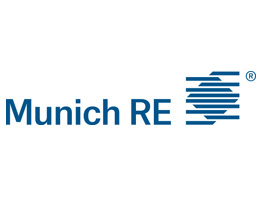Munich Re’s Doug Akerson on the Headwinds and Tailwinds Facing the Renewable Energy Sector

At RISKWORLD 2024 in San Diego, Risk & Insurance® sat down with Doug Akerson, executive vice president and MRF&C head of North America Energy, Power & Construction at Munich Re. An engineer by trade, Akerson has been a broker, an underwriter and provided due diligence on technology portfolios over the course of his career.
What follows is a transcript of our conversation, edited for length and clarity.
Risk & Insurance: What are some of the trends that you’re seeing in the property space?
Doug Akerson: There’s the advent of the more intense storms we’re seeing out there. And especially with severe convective storms and the hail phenomenon, as far as the energy space goes, we’re seeing the impact of that primarily in renewable energy and solar PV facilities.
The technology is catching up, including the ability for these panels to stow themselves, and also to predict when the storms are coming so they can protect the asset itself. But as we are seeing, to date the technology has not been deployed on a large scale.
R&I: My sense is that the move to install solar is overlapping quite a bit with the increase in severe convective storms that we’re seeing. The Southwest, for example — that’s where the investment’s happening, but that’s also where hail is becoming more threatening.
DA: You can go through risk maps or look at historical figures as far as where you have seen the highest intensity of hail or hailstorms, thunderstorm cells. But it has also crept into some other areas that are, let’s say, less prone to having these hailstorms, and we’re seeing events in other geographic regions. And that has led to losses for the industry on the solar PV side where you wouldn’t really have expected to have a loss.
R&I: It’s clear how hail can damage solar panels. Do you see other emerging energy technologies facing similar perils?
DA: Battery energy storage systems are built on a technology that has been around for a long time. Now, it’s starting to be deployed to manage the grid’s stability. But with their commercialization and large-scale deployment, there are new manufacturers coming into the space, and we have witnessed thermal runaway events on some of these batteries. So we are actually keeping a close eye on that.
Straight line wind in the form of derechos is also a concern, not only for solar PV but also for wind farms.
R&I: What do you mean by a runaway event — is that a fire issue?
DA: It’s excessive heat. It could be a fire or it could be excessive heat, but it deploys the fire suppression system, and you basically have a total loss. That’s why instead of having open racks, we’ve gone to containerized systems, which are typically deployed in open fields as opposed to buildings.
There’s also the advent of newer technologies like hydrogen fuel augmentation, which is cleaner. There needs to be significant investments in that arena, and then it’s going to be a question of supply chain and the cost to do it. Right now, it’s prohibitively expensive to produce hydrogen via electrolysis — there’s different ways you can do it, but it’s starting to enter into the energy equation. We’ll see, over the next five, 10, 20 years, that it’s going to ramp up drastically.
R&I: My understanding is that hydrogen is created using other sources of power — it’s not something that’s going to be fed into the grid; it draws off the grid, so you’re then looking for other sources of power to produce it.
DA: It’s a spectrum. Green hydrogen is where you’re using solar, wind — something that’s renewable and sustainable to produce the electricity for electrolysis to strip out the hydrogen. But there’s others; you can use nuclear to do the same.
R&I: So the application for hydrogen will primarily be things like transportation, not manufacturing or residential power supply?
DA: Transportation, yes, and also as an energy source for augmenting the fuel used in power plants. For example, thermal power plants — if you have a natural gas plant, you can actually use hydrogen as a blend within the fuel mix.
R&I: Speaking of which, the Inflation Reduction Act has spurred a lot of new construction in the renewable space. Have you been feeling its effects?
DA: It’s a stimulus, so it’s going to accelerate the deployment of additional renewable energy projects. You’ve had production tax credits, and investment tax credits have been there, and there was always the question, are they going to be renewed to keep the industry going?
So the industry would stop, start, stop, start. And now you have the Inflation Reduction Act, and you have a huge momentum with this thing, and it’s facilitating build-out of a manufacturing base in solar PV locally.
It’s also helping build out other areas, like the supply chains for renewables, and it’s also going lead to the expansion of renewables here in the U.S.
R&I: You mentioned that build-out of renewables has grown in fits and starts. Could this be the extra little push that the industry needs to keep the ball rolling?
DA: I think this time it’s different. Because before, you had legislation that — well, there’s a history of it, where Congress would actually have to approve it for an extension, so the renewable energy industry was never certain if they would actually have that benefit, the production tax credit or the investment tax credit, whereas the Inflation Reduction Act is longer.
R&I: I just heard that the Biden administration is now looking to use the EPA to restrict or close coal and natural gas plants. What do you expect to see from that development?
DA: The EPA, the federal Environmental Protection Agency, had a press release a few weeks ago, from the Biden administration, promoting various regulations that are going to place limitations on emissions. And basically, it’s going to continue to accelerate the closure of coal-fired power plants.
These assets are legacy assets. A number of them are 40 or 50 years old, even 60 years old. They’re coming to the end of their useful life, and they’re naturally retiring.
But some are actually staying in place or haven’t been retired even though the owner/operator has stated to the public utility commissions and in the public that they are going to close these plants — but then the state comes back to them and says that you cannot close these plants because we need grid stability.
And one of the things that’s really driving the consumption of electricity is data centers. Because the nature of renewable energy production is inconsistent, this can create grid instability, and then you have to keep that coal-fired power plant online, which is unfortunate, because even if there are emission controls, it’s still a carbon emitter. &










